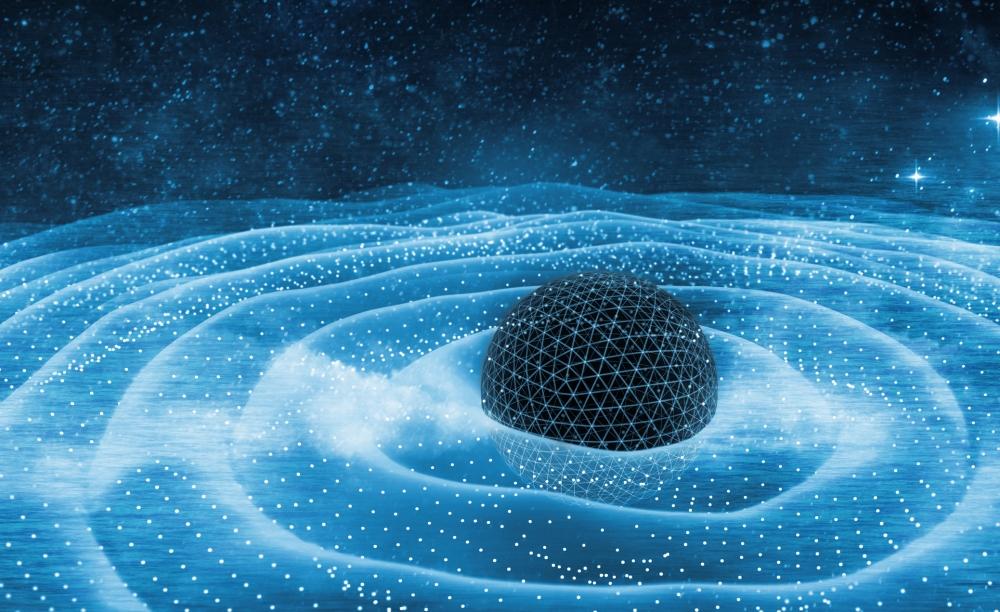“Everything with form is illusory; if all forms are seen as illusory, the Tathāgata (the Buddha) will be perceived. . . .
“Just as, in the vast ethereal sphere, stars and darkness, light and mirage, dew, foam, lightning, and clouds emerge, become visible, and vanish again, like the features of a dream—so everything endowed with an individual shape is to be regarded.”
The Diamond Sutra, which was composed sometime between the 2nd and 5th centuries CE, is famous in Mahayana Buddhism for its eloquence in describing the illusory nature of phenomena. As a scripture belonging to the Prajnaparamita (the Perfection of Wisdom) canon of Buddhist texts, which share a preoccupation with the nature of emptiness, it seeks to correct readers’ questions about what is real and unreal, what it means for us, and how we can apply such teachings in our lives in the face of the seemingly “real” world, within ourselves and without.
The Diamond Sutra states that only conditioned phenomena are unreal, that is, the way in which we perceive the world is from the conventional perspective (samvrti), and therefore unreal from the ultimate truth (paramartha). The latter points to the underlying or fundamental aspect of reality which is the unconditioned, the absolute that has names like Nirvana, dharmakaya, sunyata, tathagatha-garbha, and so on. Strictly speaking, the ultimate reality can neither be said to be real nor unreal, because it is beyond worldly dichotomies and even vocabulary or description.
Nevertheless, experience is real to us who live in the world, which is recognized as the conventional reality in Buddhism. The tricky part of this illusion is that although it is illusory, we still perceive and feel it to be real—things are as real as we believe them! Albert Einstein (1879–1955) is said something similar in a letter to family members of his late friend, Michele Besso: “For us believing physicists, the distinction between past, present and future is only a stubbornly persistent illusion.” (NPR) (He passed away only a few weeks afterward at 76.)
Since we have habitually and conditionally mistaken the conventional for the ultimate and suffer as a result (dukkha), the Buddha spent much of his time talking about the illusory nature of phenomena. Throughout my studies, like many others, I have been struck by how his teachings have been echoed by ideas in cutting-edge quantum physics today. On the deeper level of reality, phenomena are merely temporary manifestations from the quantum unified field which is the source of everything. This bears a striking equivalence to what is called the Pure Consciousness in Buddhism. As our mind or consciousness is part of the Field or Source, we co-create our reality; phenomena we experience cannot be separated from our cognitive processing of that very phenomena. Our craving and aversion arise from our sensory experiences, making us project, filter, and reflect illusions with our finite minds.
However, this is not nihilism. Neither Buddhism nor quantum physics speak of nothingness, but of a very specific kind of emptiness. Here, the word “illusion” does not mean something that does not exist, but rather something that is not what it seems to be. Therefore, it is better to qualify the illusoriness of the world with the common refrain: The world as our finite and dualistic minds perceive it is an illusion. The way we perceive the world as a self-existing object, externally made of matter, and the ego, internally made of body and mind, is an illusion. The subject-object split and all other forms of duality or separation are illusions. When we see through the illusions and let them go, they lose substantiality and therefore power over us.
To understand how quantum physics also sees the world as an illusion, I would like to point out three metaphysical “stages” that the discipline seems to point to.
Stage 1: Matter is an illusion.
According to quantum physics as a whole, matter as we know it does not exist, or at least, matter is not what it seems to be. The material world is what we might call a virtual, simulated or holographic reality made of quantum particles. These are small packets of non-conventional, intelligent, or conscious energy. They pop in and out of existence at extremely rapid speed. They are momentary manifestations, like ripples arising from and ceasing into the vast ocean. Atoms are really waves of energy, waves of potentialities rather than particles of “things.” Science now widely accepts that everything is energy. As Einstein said in the film Atomic Physics (1948): “. . . mass and energy are both but different manifestations of the same thing—a somewhat unfamiliar conception for the average mind.” (Astronomy)
This has striking affinities with the Buddha’s idea that all phenomena lack inherent existence, and are instead conditionally inter-dependent in a web of emptiness. We need to see through these illusions because our false beliefs in substantiality and our identification with the ego as real are the catalyst for suffering.
But if matter is unreal in the conventional sense how does the material world come about? While the Yogacara (mind-only) school of Buddhism is most emphatic about the material world being a projection of the mind, Mahayana Buddhism in general points toward this as the logical conclusion of seeing conventional reality as fundamentally mistaken.
Stage 2: The material world is a projection of the mind.
According to the Copenhagen interpretation, matter only manifests in space-time when there is an “observer.” These quantum phenomena are called the “collapse of the wave-function (wave-form)” and the “observer effect.” When there is no “observer,” said phenomena revert back into their primary state of wave functions, which consists of all possibilities and is potentially everywhere all at once, yet not. Here, the world of wave functions represents the pure potentiality of Pure Consciousness. The “observer” represents the dualistic mind that perceives and filters conventional reality; by its nature, it is limited and faulty. Quantum physicists and neuroscientists recognize that what we see as the world, as self, and as others exist in our mind only. Simply put, they are merely electrical signals interpreted by our brain-mind. Without human beings, there is no world as we know it. Physicist John Wheeler (1911–2008) said, “No phenomenon is a real phenomenon until it is an observed phenomenon.” (Futurism) He stated that observers’ consciousness is required to bring the universe into existence, and thus he coined the phrase “Participatory Universe.”
Nowadays, many physicists, such as Menas Kafatos, John Hagelin, and Lothar Schafer recognize that quantum particles are the stuff of the mind. Such recognition is in parallel with Ven. Chin Kung’s comment that quantum particles are actually our thoughts. Quantum physics has striking parallels with the Buddhist teaching of, “Mind-only without objective reality (weishu wu jing 唯識無境).” That is, reality as we know it is a projection of the mind, its very existence depending on the way we perceive it. The renowned psychologist and spiritual leader, Dr. Wayne Dyer (1940–2015) said, “When you change the way you see the world, the world you see changes.” (Wayne Dyer)
Our minds are energy, but encoded with information. Since reality is malleable depending on our consciousness, we are constantly co-creating realities at individual and collective levels. The mind is a wonderful tool for living and being in the world if we make it work for us, instead of against us.
Stage 3: The mind is the projection of Pure Consciousness; all is Mind.
There is a type of field theory in physics called Unified Field Theory, whose proponents seek to describe reality in its totality. In the absence of the fabled reconciliation between general relativity and quantum mechanics (quantum gravity), theories of everything typically align with ideas like Superstring Theory and M Theory.
In Unified Field Theories, the unified field is the fountainhead of all the laws governing the functioning of the universe. This fundamental basis could be described as pure abstract existence or being, pure intelligent energy, and pure potentiality. According to physicist John Hagelin, the unified field is ceaselessly emerging to its surface of what is called “vacuum energy” in the form of vibrating “super strings.” The unified field is seen to be intrinsically infinite, dimensionless, timeless, and dynamic. It is self-recognizing, self-interacting and self-organizing. These ideas echo what Max Planck (1858–1947), father of quantum mechanics, said in his acceptance speech of the 1918 Nobel Peace Prize for Physics: “All matter originates and exists only by virtue of a force. . . . We must assume behind this force the existence of a conscious and intelligent mind. This Mind is the Matrix of all matter.” (Aish)
One may then ask: what is the relationship between matter, mind/consciousness and Consciousness/Mind (with a capital C and M)? I would suggest that matter seems to be taking place in the mind or consciousness, which has dominance over matter; but mind is taking place in Consciousness or Mind, the fundamental ground. Reality is like an onion: one level of reality is within a higher one, which in turn is within a yet higher one. Consciousness is fundamental, mind is secondary, and matter is tertiary.
The metaphysical principles taught by the Buddha seem to be finding greater affinity with mainstream science, particularly quantum physics. Yet we must also keep in mind that knowledge is like a finger pointing at the moon, with the moon itself beyond knowledge. The first people to admit the limitations of their knowledge are none other than quantum physicists. In a 1923 lecture, Max Planck said: “Reality is . . . just a very specific, narrow slice of that vast range of what our thoughts try to encompass.” (Max-Planck-Society)

So far, we have explored how quantum physics is moving toward these three stages of scientific truth: matter is an illusion, the material world is a projection of the mind, and the mind is the projection of Pure Consciousness—all is Mind. Nevertheless, even quantum field theory, as far as it has come, is not quite the holy grail of theoretical physics, quantum gravity. If general relativity and quantum mechanics are ever reconciled, how would our three stages look? How would they align with Buddhist emptiness and theories of the Ultimate?
What is certain for now is that ultimate reality is somehow fundamentally tied to the mind, and Mind. This Ultimate, I believe, is Buddha-nature, which is present across all reality. Should we pierce through the illusions that bind our conventional perceptions, it will flow through us and as us, transforming our cosmos into a Pure Land.
See more
Resetting the Theory of Time (NPR)
That famous equation (Astronomy)
John Wheeler’s Participatory Universe (Futurism)
Success Secrets (Wayne Dyer)
Max Planck and The Mind Who is the Matrix of all Matter (Aish)
Max Planck (Max-Planck-Society)
Related news from BDG
Related features from BDG
Geshe Tenzin Namdak: Living in a Material World
Imagining the Omnipresent, Liminal OM, Part 1














Excellent, easy-to-understand piece on a very complex topic. Thank you.
love this article. I recently came to an understanding of emptiness after years of mediation and coming from a science background it baffles me that the answer was always hidden in quantum mechanics. I had this same insight that the two were related and it comforts me to know that people out there (like yourself) also see the connections. If only I paid more attention in physics class back in college! Odd how seeing the universe for what it really is makes the voice in my head vanish and allows me to fully live in the present.